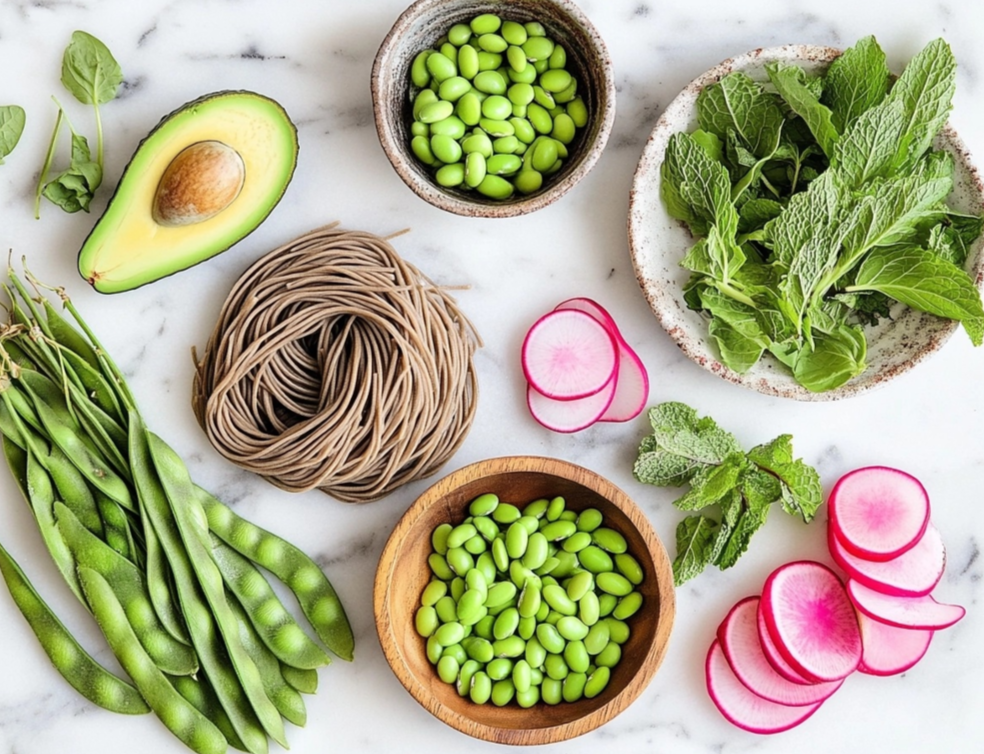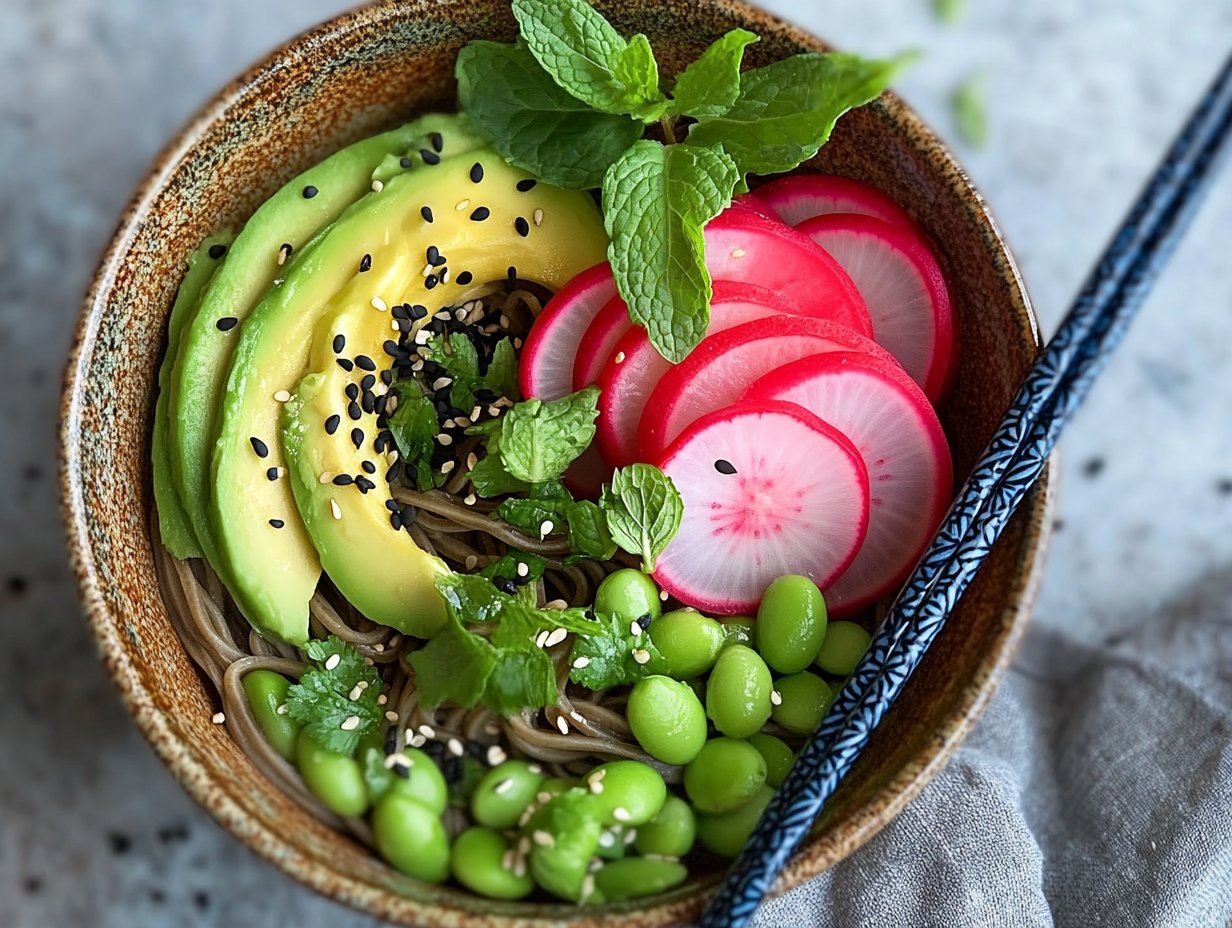A flavorful and nutritious sesame soba noodles recipe perfect for any meal.
Introduction to Sesame Soba Noodles
Sesame soba noodles blend the earthy taste of buckwheat with the rich, nutty flavor of sesame. This versatile dish can be served hot or cold, making it ideal for various occasions. Whether you’re preparing a quick weeknight dinner or an elegant meal for guests, sesame soba noodles offer both taste and nutritional benefits that cater to diverse palates.
What are Sesame Soba Noodles?
Understanding sesame soba noodles begins with knowing the fundamentals of soba and the addition of sesame. Soba noodles, made primarily from buckwheat flour, have a distinct flavor and slightly chewy texture. When combined with sesame, they gain an extra layer of richness and depth, enhancing the overall dish.
Types of Soba Noodles
There are primarily two types of soba noodles:
- 100% Buckwheat Soba: Made entirely from buckwheat flour, these noodles are gluten-free and boast a strong, nutty flavor.
- Mixed Soba: A blend of buckwheat and wheat flour, offering a balance between the earthy taste of buckwheat and the smooth texture of wheat.
Both types work well in sesame soba noodles, allowing you to choose based on your texture and flavor preferences.
Why Choose Sesame Soba Noodles?
Opting for sesame soba noodles brings numerous advantages:
- Nutritional Benefits: High in protein and fiber, low in fat.
- Flavor Profile: Combines the nutty flavor of sesame with the earthy taste of buckwheat.
- Versatility: Suitable for various dishes, from salads to stir-fries.
Health Benefits of Sesame Soba Noodles
Incorporating sesame soba noodles into your diet provides several health benefits, making them a nutritious addition to your meals.
Nutritional Value
Sesame soba noodles are packed with essential nutrients:
- High in Protein: Buckwheat is a complete protein, containing all nine essential amino acids.
- Rich in Fiber: Promotes healthy digestion and helps maintain a feeling of fullness.
- Low in Fat: Makes it a heart-healthy option for those monitoring their fat intake.
Heart Health
Regular consumption of sesame soba noodles can contribute to better heart health:
- Low in Cholesterol: Buckwheat noodles help reduce cholesterol levels.
- Rich in Antioxidants: Sesame seeds are high in antioxidants that protect the heart from oxidative stress.
Weight Management
Sesame soba noodles are an excellent choice for those looking to manage their weight:
- Low in Calories: A satisfying meal that doesn’t contribute to excessive calorie intake.
- High in Fiber: Keeps you feeling full longer, reducing the urge to snack between meals.
Additional Health Benefits
Beyond the primary benefits, sesame soba noodles offer:
- Gluten-Free Options: 100% buckwheat soba noodles cater to those with gluten sensitivities.
- Vitamins and Minerals: Rich in manganese, magnesium, and B vitamins, supporting overall health.
- Energy Boost: The complex carbohydrates in soba provide sustained energy levels.

How to Cook Sesame Soba Noodles
Preparing sesame soba noodles is straightforward and can be customized to suit your taste. Follow these steps to create a perfect bowl every time.
Cooking Instructions
- Boil Water: Fill a large pot with water and bring it to a boil.
- Cook Noodles: Add the soba noodles to the boiling water and cook according to the package instructions, usually about 4-5 minutes.
- Drain and Rinse: Once cooked, drain the noodles and rinse them under cold water to remove excess starch and prevent sticking.
- Prepare Sesame Dressing: In a bowl, mix sesame oil, soy sauce, rice vinegar, honey, and a pinch of red pepper flakes for a balanced dressing.
- Combine and Toss: Toss the cooled soba noodles with the sesame dressing, ensuring they are evenly coated.
Tips for Perfect Noodles
- Avoid Overcooking: Soba noodles should be tender yet firm to the bite (al dente). Overcooking can make them mushy.
- Rinse Thoroughly: Rinsing soba noodles under cold water after cooking removes excess starch and prevents clumping.
- Use High-Quality Ingredients: Fresh sesame oil and good-quality soy sauce enhance the overall flavor of the dish.
Enhancing the Flavor
To elevate the flavor of your sesame soba noodles, consider the following additions:
- Fresh Herbs: Add chopped cilantro or green onions for a burst of freshness.
- Spices: Incorporate garlic or ginger into the dressing for added depth.
- Sweetness: Adjust the honey or add a touch of brown sugar to balance the savory elements.
Variations and Recipes with Sesame Soba Noodles
Sesame soba noodles are incredibly versatile and can be adapted into various recipes to keep your meals exciting and flavorful.
Cold Sesame Soba Noodle Salad
A refreshing dish perfect for hot summer days:
- Ingredients: Soba noodles, julienned vegetables (carrots, cucumbers, bell peppers), sliced green onions, toasted sesame seeds.
- Dressing: Sesame oil, soy sauce, rice vinegar, honey, garlic, ginger.
- Instructions: Combine all ingredients and toss with the dressing. Chill before serving.
Stir-Fried Sesame Soba Noodles
A hearty and satisfying meal:
- Ingredients: Soba noodles, mixed vegetables (broccoli, snap peas, bell peppers), protein of choice (tofu, chicken, beef), garlic, ginger.
- Sauce: Soy sauce, hoisin sauce, sesame oil, chili paste.
- Instructions: Stir-fry the vegetables and protein, add the noodles and sauce, and cook until everything is well combined and heated through.
Sesame Soba Noodle Soup
A comforting and nourishing option:
- Ingredients: Soba noodles, vegetable or chicken broth, mushrooms, spinach, tofu, green onions.
- Flavorings: Soy sauce, miso paste, sesame oil.
- Instructions: Heat the broth, add the flavorings, and then incorporate the vegetables and tofu. Add the noodles just before serving to keep them from becoming too soft.
Spicy Peanut Sesame Soba Noodles
A flavorful twist with a kick:
- Ingredients: Soba noodles, shredded carrots, red cabbage, cilantro, peanuts.
- Sauce: Peanut butter, soy sauce, lime juice, sesame oil, sriracha.
- Instructions: Mix the sauce ingredients until smooth, toss with the noodles and vegetables, and garnish with peanuts and cilantro.
Sesame Soba Noodle Wraps
A portable and healthy option:
- Ingredients: Soba noodles, lettuce leaves or rice paper wrappers, julienned vegetables, avocado slices, grilled shrimp or tofu.
- Sauce: Sesame soy dressing or peanut sauce.
- Instructions: Assemble the ingredients in lettuce leaves or rice paper wrappers, drizzle with sauce, and roll tightly.
Sesame Soba Noodle Bowl with Avocado
A creamy and satisfying bowl:
- Ingredients: Soba noodles, sliced avocado, cherry tomatoes, cucumber, radishes, edamame.
- Dressing: Sesame oil, soy sauce, lime juice, honey, garlic.
- Instructions: Combine all ingredients in a bowl, pour over the dressing, and toss gently to mix.
Pairing Sesame Soba Noodles with Other Dishes
Enhance your sesame soba noodles experience by pairing them with complementary dishes and beverages.
Complementary Side Dishes
- Gyoza (Japanese Dumplings): Adds a savory and filling component to your meal.
- Edamame: A simple and nutritious side that pairs well with the noodles.
- Spring Rolls: Fresh or fried, they offer a delightful contrast in texture.
Beverage Pairings
- Green Tea: Complements the nutty flavors of the sesame.
- Sake: A traditional Japanese rice wine that pairs beautifully with soba noodles.
- Iced Jasmine Tea: A refreshing option for a light and aromatic pairing.
Adding Protein
Incorporate proteins to make your meal more substantial:
- Grilled Chicken: Adds lean protein and pairs well with the nutty sauce.
- Tofu: A great vegetarian option that absorbs the flavors of the dressing.
- Shrimp: Offers a sweet and succulent addition to the noodles.
Complementary Dishes from Our Website
For a well-rounded meal, consider adding No-Bake Cheesecake Cups for a sweet finish or Bacon and Sausage for a savory complement to your sesame soba noodles.
Seasonal Pairings
- Spring: Incorporate fresh, seasonal vegetables like asparagus and peas.
- Summer: Serve with a light cucumber salad and grilled vegetables.
- Autumn: Add roasted squash and kale for a hearty twist.
- Winter: Pair with warming soups and stews for a comforting meal.
Storing and Preserving Sesame Soba Noodles
Proper storage ensures that your sesame soba noodles remain fresh and delicious for future meals.
Refrigeration Tips
- Use Airtight Containers: Store the noodles in airtight containers to prevent them from drying out or absorbing odors from other foods.
- Separate Dressing: Keep the dressing separate until you’re ready to serve to maintain the noodles’ texture.
- Consume Within 3 Days: For the best flavor and safety, enjoy the noodles within three days of preparation.
Freezing Methods
While soba noodles are best enjoyed fresh, you can freeze them for longer storage:
- Blanch and Freeze: Briefly blanch the noodles, cool them, and spread them out on a baking sheet before transferring to a freezer-safe container.
- Use Within 1 Month: For optimal quality, use the frozen noodles within a month. Thaw them in the refrigerator before reheating.
Thawing Techniques
- Refrigerator Thawing: Allow the noodles to thaw slowly in the refrigerator overnight.
- Cold Water Thawing: Submerge the sealed container in cold water for quicker thawing, changing the water every 30 minutes.
Reheating Tips
When reheating sesame soba noodles, do so gently to preserve their texture:
- Microwave: Heat in short intervals, stirring in between to ensure even heating.
- Stovetop: Warm the noodles in a pan with a splash of water or broth, tossing gently to prevent sticking.
Frequently Asked Questions
Are soba noodles healthy for you?
Yes, soba noodles are a healthy option. They are high in protein and fiber, low in fat, and contain essential nutrients like manganese and thiamine. Additionally, 100% buckwheat soba noodles are gluten-free, making them suitable for those with gluten sensitivities.
What does sesame noodle taste like?
Sesame soba noodles have a rich, nutty flavor from the sesame oil, complemented by the earthy taste of buckwheat. The combination creates a balanced and savory profile that is both satisfying and aromatic.
What is a soba noodle made of?
Soba noodles are primarily made from buckwheat flour, which gives them their distinctive flavor and texture. Some soba noodles are made with a blend of buckwheat and wheat flour, which affects their taste and makes them more pliable.
What is the difference between noodles and soba noodles?
While all soba noodles are a type of noodle, not all noodles are soba. Soba noodles are specifically made from buckwheat or a mixture of buckwheat and wheat flours, giving them a unique flavor and texture. In contrast, regular noodles can be made from various types of flours, such as wheat, rice, or eggs, resulting in different tastes and consistencies.
Conclusion
Sesame soba noodles are a versatile and nutritious addition to any meal, offering a delightful combination of flavors and textures. Whether served cold in a refreshing salad, stir-fried with vegetables and protein, or enjoyed in a comforting soup, these noodles provide both health benefits and culinary satisfaction. By following our comprehensive guide and experimenting with various recipes, you can master the art of preparing sesame soba noodles and incorporate this delicious dish into your regular cooking repertoire. Embrace the rich, nutty flavors and enjoy the numerous health advantages that come with every serving of sesame soba noodles.

